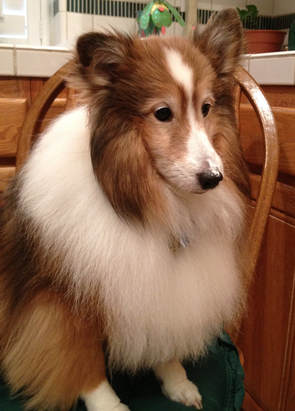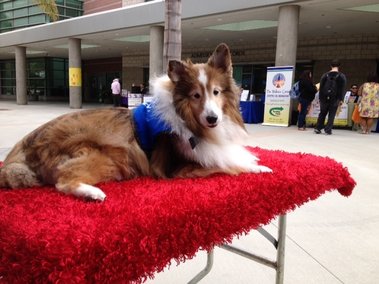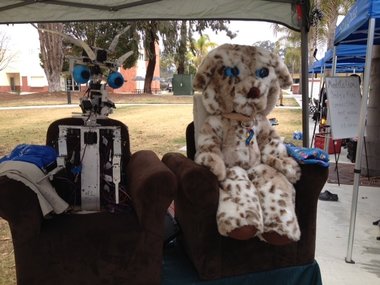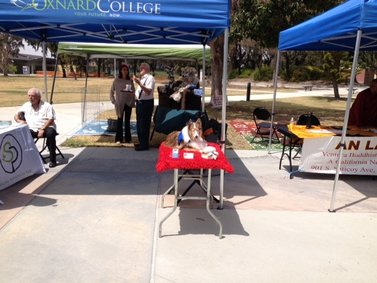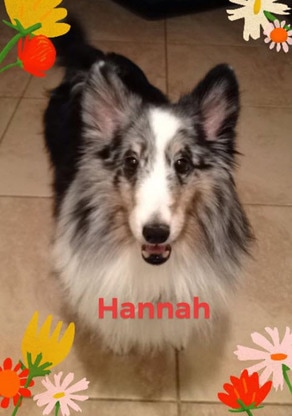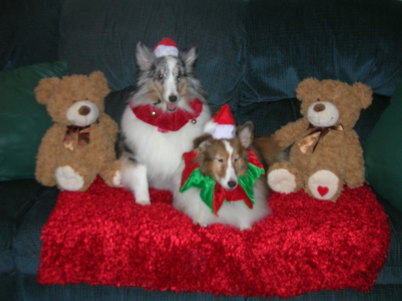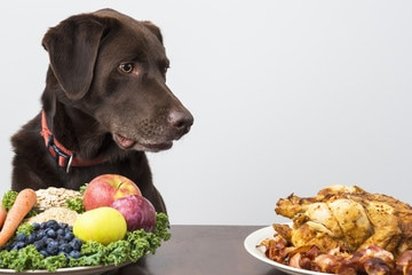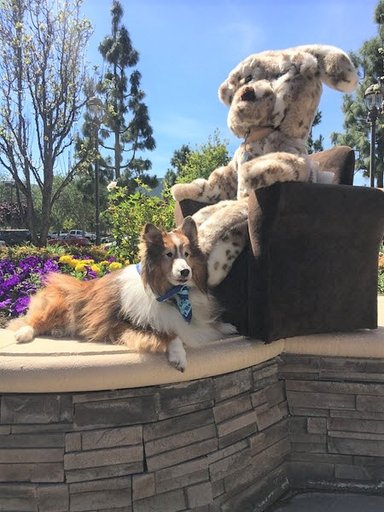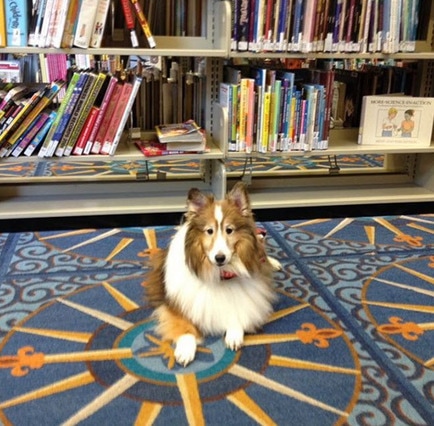Landon’s Apple Carrot Dog Treats1 cup of whole wheat flour, brown rice flour, or gluten free flour
1 cup of grated carrots 1 tsp. baking powder 1 egg ½ cup unsweetened apple sauce ½ tsp. salt (optional, but the salt helps extend the shelf life of the treats) Preheat oven to 350 degrees F. Mix the ingredients together until dough forms. Roll the dough into small balls and place them on a cookie sheet lined with parchment paper. Press each dough ball down slightly so the biscuits are about ¼ inch thick. Bake until golden brown (about 30-40 minutes) and then let the treats cool on a wire rack. Makes about 2 dozen small treats.
0 Comments
When Landon had healed enough to be introduced to soccer, Hannah (who is the family soccer star) was careful with him and watched his every move. As Landon grew stronger, so did his bond with Hannah. They played together, kissed each other, and slept by each other. Over the next few years, as Cosette, Molly, Mishka, and Shelby aged and passed away, Hannah grew even closer to Landon. They hung out together, and Hannah even accompanied Landon to some of his community and charity events.
When Hannah arrived in her new home, she did not seem to know what a house was, as she had likely been kept outside for her entire young life. She had an innate sweetness about her and was also innocently wild, running and jumping around like a gazelle in her own little world. She had a lot of learning to do, but it was apparent early on that she was sensitive and very wise. She seemed very aware of human emotions and she aimed to please. To learn how to walk on a leash, she was teamed with Cosette (who was an amazing walker, having been trained for dog shows by her breeder, prior to the breeder abandoning her). Hannah learned well, and she herself became an expert walker, who served as a walking mentor for Landon and also later on, for her newest sheltie sister, Tessa. Hannah is quite shy around new people and dogs, but she braved going to obedience school, even graduating with honors.
aggression, disobedience, and destructiveness. This is because behavior is regulated by neurotransmitters and hormones in the brain, and nutrition impacts the availability of these chemicals. To optimize your pet's nutritional intake, follow these tips: Tip #1 - Remember that Dogs are Not Humans Dogs have different nutritional needs than people. Feeding your pet a diet of only “people food” may lead to nutrient deficiencies and related health problems, as well as obesity and finicky eating behavior. Tip #2 - Read Labels Although pet food labels may look intimidating, you can simplify label reading by zeroing in on a few specific things. First, ensure that the pet food is labeled “complete and balanced,” indicating the food’s adherence to requirements set by the Association of American Feed Control Officials (AAFCO) — a non-profit organization that sets standards for both animal feeds and pet foods in the United States. While this does not guarantee optimal nutrition, it is a basic point in pet food consideration, since it recognizes ingredient content that will sustain life. Also, when seeking food for a puppy, look for a pet food that is formulated “for puppies.” This will help ensure that the food contains ingredients and nutrients that are of special concern for puppies. Tip #3 – Consider Pet Food Forms Commercial pet foods are available in three basic forms: moist, semi-moist, and dry. Moist foods contain from 60% to over 87% moisture, and are preserved with heat sterilization and vacuum preservation in an anaerobic environment. Nutrient stability is considered excellent for up to 18 months, however, a single freeze-thaw cycle seriously damages the food. Many moist foods that are packaged in cans or trays are considered “complete and balanced,” yet those packaged in tubes (called “chubs”) tend to be less so. Semi-moist foods have a moderate water content of 25% to 35%, and are exposed to a heat-based extrusion process, after which humectants and organic acids are added to control water activity and inhibit mold growth. The finished product is packaged in pouches or wrappers, which may offer feeding convenience; however, semi-moist foods also usually contain more meat meals, sugars, and artificial flavors than moist or dry foods, and can be relatively costly. Dry foods contain between 3% and 11% water, and are usually formed through a heat-based extrusion process. Some dogs prefer moist or semi-moist foods over dry, yet the energy density and nutritional value of dry foods makes them a more cost-efficient option, with dry foods costing about one-third as much as moist or semi-moist foods on a cost-per-calorie basis.
This means a diet containing substantial levels of meat-based protein and natural fats and oils, as well as some healthy carbohydrates from high-quality grains, vegetables, and/or fruits. Raw foods can indeed be a healthy part of this diet, yet care needs to be taken to ensure that the foods are safe, since raw meat has been known to contain bacterial pathogens such as Salmonella, Escherichia coli, and Clostridium perfringens. This is true even when freezing, freeze-drying, or applying grape seed extract to the meat, since these practices do not adequately kill microorganisms. Bacterial pathogens pose health risks to animals, with symptoms including severe vomiting, diarrhea, pain, weakness, and/or cutaneous ulcerations. People too, may be impacted by these pathogens, which can be transferred via direct contact with food/utensils, or by contact with the contaminated environment shared between people and pets (including contact with pet feces). Thus, extreme care needs to be taken with raw food diets in order to protect both animals and people. Tip #5 - Be Cautious Note that ingredients listed on labels are in descending order by their predominance in weight according to the product’s formula. This means that ingredients that are high in moisture have a higher weight than dry ingredients, and therefore, appear at the top of the ingredient list. This can be deceiving because moisture-rich meat may appear at the top of the list, along with “water for processing.” This suggests that the primary ingredient in the food is meat, when it may actually be dry grain (e.g., soy, corn, oats, etc.), which is mixed with the water during processing. In such situations, you may need to consider the overall reputation of the manufacturer in order to best assess the food’s quality. Certain labeling terms also give reason for concern. Be cautious of the term “by-products,” especially when it is at the top of the ingredient list. While some by-products (e.g., liver, kidney, lungs) have nutritive value, others (e.g., udder, bone, and connective tissue) do not. Also, avoid products with high-listed or multiple forms of sugar (e.g., molasses, sucrose, caramel, corn syrup), high levels of sodium, or an abundance of artificial flavors and colors. Beware too of the additive, ethoxyquine, which is a synthetic preservative linked to skin allergies, reproductive problems, and organ failure in dogs. Note that dry foods preserved with natural antioxidants (e.g., Vitamins C and E, rosemary, citric acid) may have a somewhat shorter shelf life than those containing synthetic preservatives, but they also have fewer toxic and allergenic effects. Tip #6 – Ask the Experts A veterinarian can assess if your dog or puppy needs a special food or medication to treat any current health issues. Veterinarians are also knowledgeable about breed-specific concerns that may influence what your dog or puppy should eat. This includes issues involving large- or giant-breed puppies and their graduated need for certain nutrients to enhance orthopedic health. Additionally, veterinarians can determine if your pet needs a nutritional supplement, as some pet foods or pet food forms may contain nutritional gaps due to its inherent qualities or mode of processing. You may also find the following online resources to be helpful in evaluating dog foods and supplements:
ReferencesBosch, G., Beerda, B., Hendriks, W. H., van der Poel, A. F. B., & Verstegen, M. W. A. (2007). Impact of nutrition on canine behavior: Current status and possible mechanisms. Nutrition Research Reviews, 20(2), 180-194. doi: 10.1017/S095442240781331X
Crane, S. W., Moser, E. A., Cowell, C. S., Millican, J., Stout, N. P., Roman, P., & Crane, S. E. (2010). Commercial pet foods. In M. S. Hand, C. D. Thatcher, R. L., Remillard, P. Roudebush, & B. Novotney (Eds.) Small animal clinical nutrition (5th ed.) (pp. 157-190). Topeka, KS: Mark Morris Institute. Debraekeleer, J., Gross, K. L., & Zicker, S. C. (2010). Feeding growing puppies: Postweaning to adulthood. In M. S. Hand, C. D. Thatcher, R. L., Remillard, P. Roudebush, & B. Novotney (Eds.) Small animal clinical nutrition (5th ed.) (pp. 311-319). Topeka, KS: Mark Morris Institute. Lee, E. (2009). How to read a dog food label. WebMD Pet Health. Retrieved from http://pets.webmd.com/dogs/guide/how-to-read-a-dog-food-label Miller, E. P., Ahle, N. W., & DeBey, M. C. (2010). Food safety. In M. S. Hand, C. D. Thatcher, R. L., Remillard, P. Roudebush, & B. Novotney (Eds.) Small animal clinical nutrition (5th ed.) (pp. 225-249). Topeka, KS: Mark Morris Institute. Remillard, R. L. (2008). Homemade diets: Attributes, pitfalls, and a call for action. Topics in Companion Animal Medicine, 23(3), 137-142. doi: http://dx.doi.org/10.1053/j.tcam.2008.04.006 Roudebush, P., Dzanis, D. A., Debraekeleer, J., & Watson, H. (2010). Pet food labels. In M. S. Hand, C. D. Thatcher, R. L., Remillard, P. Roudebush, & B. Novotney (Eds.) Small animal clinical nutrition (5th ed.) (pp. 191-206). Topeka, KS: Mark Morris Institute. Sagman, M. (2013). What would the ideal dog food look like? Dog Food Advisor. Retrieved from http://www.dogfoodadvisor.com/choosing-dog-food/ideal-dog-food/
Ricky helps children with ASD by displaying pre-programmed emotions; responding to a child's body motions and verbal questions; and making simple statements and asking questions. Also, Ricky has facial recognition ability, so he can remember each individual child and personalize his statements to that child. If you think Ricky sounds like a science fiction movie character, there's a reason for that. Ricky was designed by one of the creators of the robots used in the "Terminator," "Aliens," and "Jurassic Park" movies. Just like these robotic characters, Ricky has highly mobile limbs, and "muscles," making him seem very life-like. Top that off with a soft, furry coat and friendly eyes, and it is obvious why children love Ricky so much. In fact, on the day that Landon met Ricky, children passing by were drawn to Ricky as much as they were to Landon! Therapists who have used Ricky to treat children with ASD have reported that he helps both verbal and non-verbal children stay engaged and learn. Ricky has a large vocabulary (even in multiple languages), and by pushing a button on Ricky's control device, therapists can vary or repeat Ricky's statements and gestures. This enables therapists to teach children about how their emotions and behaviors influence someone else (in this case, Ricky). Also aiding therapists is Ricky's built-in camera, which enables a child's behavior to be monitored over time. Additionally, educators can use Ricky as a type of a teaching assistant for school kids at all educational levels. For example, Ricky can help by teaching lessons, giving assignments, scoring tests, or answering questions. Also, because Ricky speaks multiple languages and can wear a variety of outfits, he can inject a dose of fun when teaching languages, history, geography, etc. Scholastic Robotics is currently seeking therapists and educational programs to use Ricky and then provide feedback that can be used to further perfect and expand his skills. The field of robotics has tremendous potential to enhance human life, and Ricky is a wonderful example of what is possible. Partners and venture capitalists are welcome to help Scholastic Robotics prepare Ricky for widespread use within psychological treatment, education, and more. For additional information about Scholastic Robotics, see www.scholasticrobotics.com. Also, to view Ricky in action, click the button below and then scroll down to see several embedded videos. References American Psychiatric Association. (2017). What is autism spectrum disorder? Retrieved from https://www.psychiatry.org/patients-families/autism/what-is-autism-spectrum-disorder Centers for Disease Control. (2017). Autism spectrum disorder: Data and statistics. Retrieved from https://www.cdc.gov/ncbddd/autism/data.html Scholastic Robotics. (2017). Meet Ricky. Retrieved from http://scholasticrobotics.com/ As an extra fun incentive for the kids, the library where Landon works provides each dog with personal "calling cards" that contain the dog's name, photo, and fun facts about the dog. Once a child finishes reading a book, they receive the dog's card. This encourages the kids to read multiple books (to multiple dogs), so that they can collect more cards.
Most of the children in the program are between 5 and 9 years old, but sometimes they are even younger. Even though the very young ones cannot read yet, they like to look at the illustrations in the books and tell their own stories. Some of their stories are even more elaborate than the written stories. For each reading session, the library workers select an assortment of books for the children to choose from, and then each child selects a book from the group. The child then walks over to an available dog, introduces him/herself, and pets the dog. It is quite adorable. The dogs' handlers assist the children with difficult words and give them encouragement. The kids' parents seem to enjoy watching the entire process. Recently, one child's mother mentioned that at home, her 6-year-old daughter always seems to find an excuse not to practice reading, but she loves to come to the library to read to the dogs. Even better, the program has improved the child's reading. Landon's own book, "Landon Loves Life" is being launched this summer, and it may even be carried at the library where he works. That would give children the chance to actually read to the real-life star of the book. How exciting that would be! 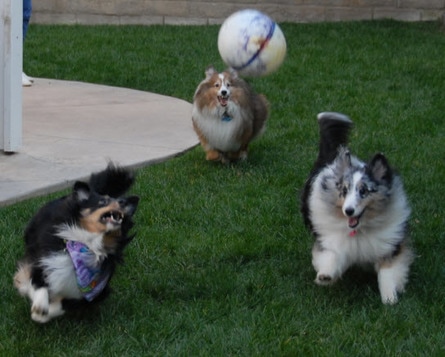 Hello Everyone, Welcome to Landon's new blog! As some of you may remember, Landon had a blog a few years ago called "sheltiebug," and it was quite popular. However, the blog's hosting service stopped supporting blogs, so the site was dismantled. At around that time, things got really busy for Landon and me (his mom), but we both have a bit more time now, and we have a lot of ground to cover. Both Landon and I are more educated now. Landon is a certified therapy dog and he graduated from advanced obedience school, and I finished my PhD (in health psychology), along with several other degrees and certifications. So, together, Landon and I should have some great stories and information for you. We will be telling you some things about Landon's therapy work, as well as about his recent assignment as a wellness ambassador for ISD Innovations -- a high-tech company that will soon be launching a suicide prevention app. Landon's own story of resiliency inspires hope, good health, and happiness, and Landon will be spreading his uplifting message to kids directly, as well as through his upcoming new book, "Landon Loves Life." Landon will also be working with a company that uses animal robots as a form of animal-assisted therapy for children with autism, so we will tell you more about that. Additionally, as Landon has gotten older, he seems to like hanging out in the kitchen more (mostly in the hope of getting a snack). He is a great cooking buddy though, so he and I will be providing some healthy dog snack recipes that you can make for your dog. Continuing on the food theme, Landon likes to go to outdoor cafes, so he will be reviewing some of these places for their paws-up or paws-down status. Landon is also still into fashion, so he will be showing off his own style, as well as perhaps commenting on award show fashions like he used to do. Landon has two sister shelties (Hannah and Tessa) who will also likely be the topic of some blogs. That's them with Landon in the photo above. Hannah (on the right) and Tessa (on the left) are both amazing soccer players, so they help keep Landon humble. Be sure to read Landon's latest blog entries. Landon and I will have a lot to report on, and we hope that you will come along for the ride. We think it will be a fun one. |
AuthorHi, I am Landon's mom and I will be helping him out with his blog. He is very smart, but he is kind of slow at typing. Archives
July 2017
Categories |
